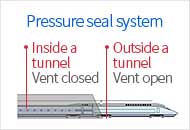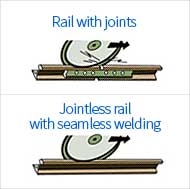Comfortable High-speed Railway
Indoor air control
-
 Indoor/outdoor temperatures and humidity conditioning with sensorsTo ensure a comfortable ride, automatic indoor air conditioning is performed by the on-board computer system in the passenger car. Once it receives data on indoor/outdoor temperature and humidity conditions, the computer automatically maintains the optimal temperature and humidity conditions.
Indoor/outdoor temperatures and humidity conditioning with sensorsTo ensure a comfortable ride, automatic indoor air conditioning is performed by the on-board computer system in the passenger car. Once it receives data on indoor/outdoor temperature and humidity conditions, the computer automatically maintains the optimal temperature and humidity conditions.
No ringing in the ear
-
 Preventing ringing in the ear by maintaining air pressure in train carsThe ear pain called “airplane ear” is a condition commonly experienced during travel by airplane or high-speed train. What causes the condition is the air pressure difference between the indoor space and the outdoor environment, and it often happens when a high-speed train goes in and out of a tunnel. But the on-board computers on KORAIL’s high-speed fleet inflate the rubber packing for the door when the speed reaches 5km/hr, blocking the air flow between the indoor and outdoor spaces. In particular, when the train passes through a tunnel, the ventilation system on the train is automatically blocked, thus preventing any changes in indoor air pressure and in turn preventing the passengers from experience a ringing in the ears.
Preventing ringing in the ear by maintaining air pressure in train carsThe ear pain called “airplane ear” is a condition commonly experienced during travel by airplane or high-speed train. What causes the condition is the air pressure difference between the indoor space and the outdoor environment, and it often happens when a high-speed train goes in and out of a tunnel. But the on-board computers on KORAIL’s high-speed fleet inflate the rubber packing for the door when the speed reaches 5km/hr, blocking the air flow between the indoor and outdoor spaces. In particular, when the train passes through a tunnel, the ventilation system on the train is automatically blocked, thus preventing any changes in indoor air pressure and in turn preventing the passengers from experience a ringing in the ears.
Quietness
-
 Jointless railConventional trains are noisy due to noise and vibration at joints on the rail. But high-speed rail does not have joints, and therefore, high-speed trains make little noise and vibration although they run much faster. This type of rail which is 300-meter long per unit are made with a special welding technique called “seamless welding.” Each unit of these rail tracks are carried to the site on a specially designed vehicle and connected with each other with seamless welding again. KORAIL is gradually replacing old rail with joints with the jointless rail made with seamless welding. Also, unlike conventional trains which have wheels under each car, high-speed trains have wheels between cars, leading to much less noise and vibration coming from the wheels. Moreover, they are powered by electricity, compared with conventional trains powered by diesel engines, which also contributes to a reduction of noise for high-speed trains.
Jointless railConventional trains are noisy due to noise and vibration at joints on the rail. But high-speed rail does not have joints, and therefore, high-speed trains make little noise and vibration although they run much faster. This type of rail which is 300-meter long per unit are made with a special welding technique called “seamless welding.” Each unit of these rail tracks are carried to the site on a specially designed vehicle and connected with each other with seamless welding again. KORAIL is gradually replacing old rail with joints with the jointless rail made with seamless welding. Also, unlike conventional trains which have wheels under each car, high-speed trains have wheels between cars, leading to much less noise and vibration coming from the wheels. Moreover, they are powered by electricity, compared with conventional trains powered by diesel engines, which also contributes to a reduction of noise for high-speed trains.